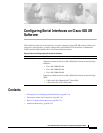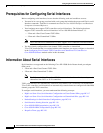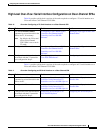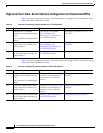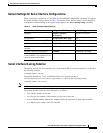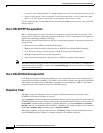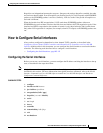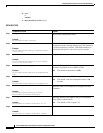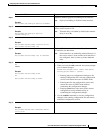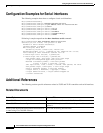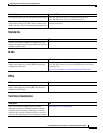
Configuring Serial Interfaces on Cisco IOS XR Software
Information About Serial Interfaces
HC-120
Cisco IOS XR Interface and Hardware Component Configuration Guide
• t1-num: T1 or E1 channel number. T1 channels range from 0 to 23; E1 channels range from 0 to 30.
• channel-group-number: Time slot number. T1 time slots range from 1 to 24; E1 time slots range
from 1 to 31. The channel-group-number is preceded by a colon and not a slash.
Use the question mark (?) online help function following the serial keyword to view a list of all valid
interface choices.
Cisco IOS XR PPP Encapsulation
PPP is a standard protocol used to send data over synchronous serial links. PPP also provides a link
control protocol (LCP) for negotiating properties of the link. LCP uses echo requests and responses to
monitor the continuing availability of the link.
PPP provides Network Control Protocols (NCPs) for negotiating properties of data protocols that will
run on the link:
• IP Control Protocol (IPCP) to negotiate IP properties
• Multiprotocol Label Switching control processor (MPLSCP) to negotiate MPLS properties
• Cisco Discovery Protocol control processor (CDPCP) to negotiate CDP properties
• IPv6CP to negotiate IP Version 6 (IPv6) properties
• Open Systems Interconnection control processor (OSICP) to negotiate OSI properties
Note The default encapsulation type for the serial line card configurations is Cisco HDLC. To change the
encapsulation type to be PPP, you must use the encapsulation ppp command in interface configuration
mode for the serial interface.
Cisco IOS XR HDLC Encapsulation
Cisco High-Level Data Link Controller (HDLC) is Cisco’s proprietary protocol for sending data over
synchronous serial links using HDLC. Cisco HDLC also provides a simple control protocol called Serial
Line Address Resolution Protocol (SLARP) to maintain serial link keepalives. HDLC is the default
encapsulation for serial interfaces under Cisco IOS XR software.
Keepalive Timer
The HDLC usage of the keepalive timer also applies to PPP encapsulation to control how often
ECHOREQ (echo request) packets are sent out.
Use the keepalive command in interface configuration mode to set how frequently LCP should send out
ECHOREQ packets to its peer. To restore the system to the default keepalive interval of 10 seconds, use
the keepalive command with no argument. To disable keepalives, use the no keepalive or keepalive
disable command. For both PPP and Cisco HDLC, a keepalive of 0 disables keepalives and is reported
in the show running-config command output as keepalive disable.
When LCP is running on the peer and receives an ECHOREQ packet, it should respond with an echo
reply (ECHOREP) packet, regardless of whether keepalives are enabled on the peer.



